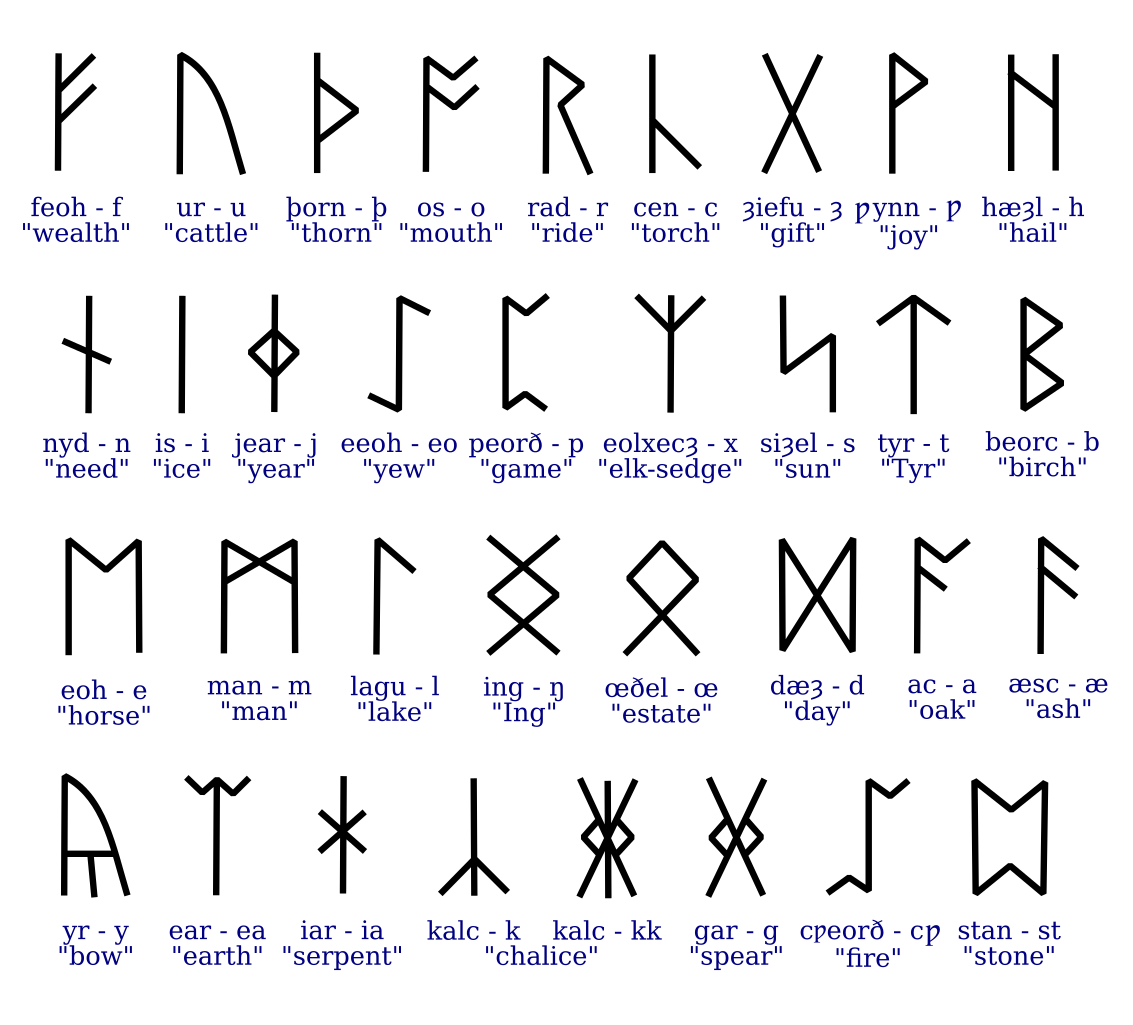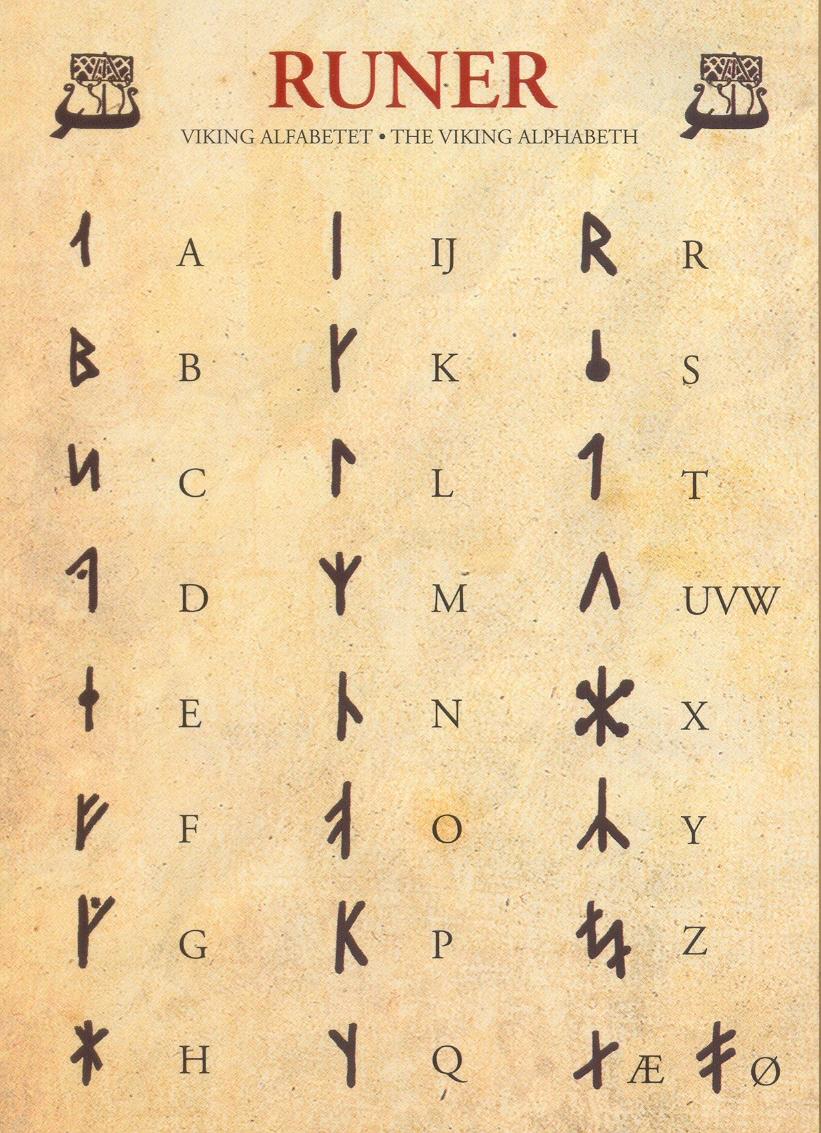AngloSaxon Runes font

Anglo Saxon Rune Stones Handmade Ancient Alphabet Fair Trade Sies
So, after the Roman departure in the 5th century CE the vacuum in England was filled by Angles, Saxons, and Jutes, collectively referred to as the Anglo-Saxons. They brought the early runes with them, which at this time had settled into an 'alphabet' of sorts. This rune row, or the linear sequence of runes, was called the Elder Futhark and.

FileAnglosaxonrunes.svg Wikipedia
The Elder Futhark (or Fuþark ), also known as the Older Futhark, Old Futhark, or Germanic Futhark, is the oldest form of the runic alphabets. It was a writing system used by Germanic peoples for Northwest Germanic dialects in the Migration Period.

Pin on History
The Rune Converter transforms Roman alphabet, as used in modern English, into five systems of Germanic runic writing: Elder Futhark, Anglo-Saxon runes, Long Branch Younger Futhark, Short Twig Younger Futhark and staveless runes (note that it does not translate the words themselves, it only converts letters into runes).

Northumbrian (latest AngloSaxon) runes.. Image 1 Anglo saxon tattoo, Anglo saxon runes, Runes
Runes were a form of writing used across Northern Europe during the early Middle Ages - the time of the Anglo-Saxons and Vikings. Tolkien adapts a few of the real signs and gives a key to translating them. It is important to point out that runes have NO connection with the occult, with witchcraft, or necessarily with paganism.

Old Saxon Runes chart, extended from Elder Futhark. An ancient writing system of Germanic tribes
(b) a > æ when not followed by a nasal consonant; (c) Gmc. *ai > OE ā; Gmc. *au > OFris. ā. A good example of these changes is the name Oswald, the first element of which (ōs-), due to nasalization, reflects the common Germanic *ans-, found in the name of the *ansuz rune.

AngloSaxon Runes font
The three best-known runic alphabets are the Elder Futhark ( c. AD 150-800), the Anglo-Saxon Futhorc (400-1100), and the Younger Futhark (800-1100).

AngloSaxon Futhorc Anglo saxon runes, Anglo saxon tattoo, Runic alphabet
The Anglo-Saxon script added letters to the futhark to represent sounds of Old English that did not occur in the languages that had used the Early Germanic script. Anglo-Saxon had 28 letters, and after about 900 ad it had 33. There were also some slight differences in letter shape.

Words for Granted
Anglo Saxon Runes When the Anglo-Saxons became Christians, they began to use the Roman alphabet for writing (as we still do today). Before that time, they wrote in runes like these: Each rune had a name, such as 'joy' or 'ash tree' . The runes were all made of straight lines, which made them easier to carve.

Pin on ANS Website Blog
The runic alphabet used by the people of northwest Europe for more than a thousand years contains two great mysteries.. Elder Futhark is the ancestor of Anglo-Saxon runes, and also of the 16.

AngloSaxon runes education Runic alphabet, Alphabet code, Alphabet
The Anglo-Saxon Futhorc, or alphabet, is a set of runes which were used as a writing system before the adoption of the Latin alphabet. The characters are formed from straight lines to make them easier to carve into wood, or occasionally metal or stone; ink and parchment were not generally used for writing before the arrival of the Christian Church.

AngloSaxon Runes Ancient alphabets, Anglo saxon runes, Rune alphabet
Anglo-Saxon runes (futhorc/fuþorc) Old English / Anglo-Saxon was first written with a version of the Runic alphabet known as Anglo-Saxon or Anglo-Frisian runes, or futhorc/fuþorc. This alphabet was an extended version of Elder Futhark with between 26 and 33 letters.

My Picture Postcards Viking Alphabet Runic alphabet
Anglo-Saxon runes are an extended version of Elder Futhark consisting of between 26 and 33 letters. It is thought that they were used to write Old English / Anglo-Saxon and Old Frisian from about the 5th century AD.

Anglo Saxon Alphabet, Anglo Saxon Runes, Celtic Runes, Ancient Runes, Viking Symbols, Viking
This teacher-made Anglo-Saxon runes worksheet has been designed to supplement your lessons on Anglo-Saxons and their language in your KS2 class. Show more Related Searches anglo saxons runes anglo saxon anglo saxons ks2 anglo saxon craft ideas viking runes Ratings & Reviews Curriculum Links Make a Request Resource Updates
Year 4 Runes...the Anglosaxon alphabets
Anglo-Saxon runes ( Old English: rūna ᚱᚢᚾᚪ) are runes used by the Anglo-Saxons as an alphabet in their native writing system. Today, the characters are known collectively as the futhorc (ᚠᚢᚦᚩᚱᚳ fuþorc) from the sound values of the first six runes. The futhorc was a development from the 24-character Elder Futhark.

The AngloSaxon runes which are known as futhorc. They remained in use in AngloSaxon England
Anglo-Saxon runes has its origins in the older Futhark, but enjoys further in Friesland in the current North-West Germany, where Saxons lived 400 years before they immigrants and occupied the British Isles.. In the Nordic / Germanic runic alphabet is the first 5 runes fuþark, but the first 5 runes in the Anglo-Saxon runic alphabet is fuþorc .

Pin on ANS Website Blog
Anglo-Saxon Futhorc Younger Futhork Hungarian Runes (Székely Rovásírás) Turkic (Orkhon) Runes Cirth (Tolkein's Runic-like alphabet) Elder Futhark Elder Futhark is thought to be the oldest version of the Runic alphabet, and was used in the parts of Europe which were home to Germanic peoples, including Scandinavia.